|
|
|
Sort Order |
|
|
|
Items / Page
|
|
|
|
|
|
|
| Srl | Item |
| 1 |
ID:
188068
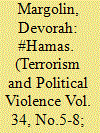

|
|
|
|
|
| Summary/Abstract |
As the debate on whether Hamas should be designated a terrorist organization intensifies across Europe and North America, policymakers and practitioners seek to identify the core principles that unify the group and its ideology. This paper contributes to this discussion by examining how Hamas uses Twitter to frame its narrative to English-speakers around the world. From March 2015 until November 2019, when its account was suspended from Twitter, Hamas operated an English-language Twitter handle under the name @HamasInfoEn. Using thematic content analysis to explore the first 2,848 tweets sent by Hamas in English—between March 2015 and March 2018—this paper explores the socio-political and religious narratives that lay at the core of Hamas’s online public diplomacy throughout its first three years on Twitter. Since its entrance into politics in 2006, some academics argue that Hamas has increasingly sought to distance itself from acts of terrorism and legitimize its actions as a governing actor, thereby seeking to carve out a place for itself in the international community. This study presents a nuanced understanding of how Hamas represents itself internationally, to better understand where the group is going, and how to best counter its narratives.
|
|
|
|
|
|
|
|
|
|
|
|
|
|
|
|
| 2 |
ID:
188108
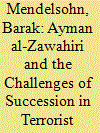

|
|
|
|
|
| Summary/Abstract |
What challenges do newly appointed terrorist leaders face? The paper proposes four primary needs all new leaders consider, including acceptance by the organization’s members, assuming control, maintaining organizational coherence and unity, and overcoming counterterrorism pressures. The magnitude of each challenge may differ depending on the predecessor’s character, the organization’s institutionalization level, the group’s ideological and strategic coherence, the availability of material resources, and communal support. This analytical framework is then used to assist the paper’s second objective: understanding how Ayman al-Zawahiri, who succeeded bin Laden, negotiated these challenges and the tradeoffs he made. Shifts in Al Qaeda’s operational environment required al-Zawahiri to confront challenges more complex than his predecessor had faced, even as he had fewer tools to solve them. Facing authority crisis, magnified by the incoherence between Al Qaeda’s central leadership and its branches and Al Qaeda’s inability to control its branches, al-Zawahiri increased decentralization, embraced affiliates’ local focus, promoted efforts to raise Al Qaeda’s local appeal, and sought to reduce U.S. interest in targeting the group. He kept Al Qaeda alive, but saw its stature shrink significantly.
|
|
|
|
|
|
|
|
|
|
|
|
|
|
|
|
| 3 |
ID:
188084


|
|
|
|
|
| Summary/Abstract |
Terrorist attacks carried out by individuals have significantly accelerated over the last twenty years. This type of lone-actor (LA) terrorism stands as one of the greatest security threats of our time. While the research on LA behavior and characteristics has produced valuable information on demographics, classifications, and warning signs, the relationship among these characteristics is yet to be addressed. Moreover, the means of radicalization and attacking have changed over decades. This study conducts an a-posteriori analysis of the temporal changes in LA terrorism and behavioral associations in LAs. We initially identify twenty-five binary behavioral characteristics of LAs and analyze 190 LAs. Next, we classify LAs according to ideology first, incident-scene behavior (determined via a virtual attacker-defender game) secondly, and, finally, the clusters obtained from the data. In addition, within each class, statistically significant associations and temporal relations are extracted using the A-priori algorithm. These associations would be instrumental in identifying the attacker’s type and intervening at the right time. The results indicate that while pre-9/11 LAs were mostly radicalized by the people in their environment, post-9/11 LAs are more diverse. Furthermore, association chains for different LA types present unique characteristic pathways to violence and after-attack behavior.
|
|
|
|
|
|
|
|
|
|
|
|
|
|
|
|
| 4 |
ID:
188105


|
|
|
|
|
| Summary/Abstract |
Prior research on female participation in militant organizations explores organizational and individual factors that influence women’s recruitment, and the roles women fulfill. However, most research focuses either on transnational organizations or local militant groups. Within this study, we explore how linkages with transnational groups shape female participation within their overseas affiliate organizations. We employ an original dataset of female militants arrested or killed between 2014 and 2019 in the Philippines, Malaysia, and Indonesia, accounting for organizational affiliation. Overall, we find that female participation in militant groups increased between 2015 and 2017, with most of the increase associated with the Islamic State. While most women with an Islamic State association assumed non-combat roles, more than a third assumed combatant roles, indicating the influence of country-level and regional dynamics. Based on our data, female combatants with an Islamic State association served exclusively as either suicide attackers or conducted bombings, diverging from the varied roles assumed by women combatants in other groups in the region. Overall, our findings highlight how the nature of transnational organizations can combine with the local dynamics of their affiliate groups to produce unique trends in the local female militant landscape.
|
|
|
|
|
|
|
|
|
|
|
|
|
|
|
|
| 5 |
ID:
188080
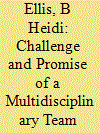

|
|
|
|
|
| Summary/Abstract |
Violent radicalization is a complex process that results from multiple influences and experiences across the settings and contexts of an individual’s life. No single pathway or characteristic determines who is at risk for it. Given this understanding, no single intervention aimed at this multiply-determined problem is likely to be successful if it is implemented in isolation. Multidisciplinary team approaches are increasingly seen as holding promise in the prevention and intervention of violent radicalization in the United States and internationally. A multidisciplinary team is typically a group of professionals who are members of different fields of study (psychology, medicine, social work, etc.) who provide a specific service to an individual. Team members independently focus on the issues in which they specialize and activities of the team are coordinated with a common goal. This paper aims to extend current knowledge by addressing questions related to challenges in implementing a multidisciplinary team approach with the capacity to address violent radicalization, presenting potential solutions to these challenges as well as highlighting one multidisciplinary team, Community Connect, that successfully worked with youth identified as being at risk for violence.
|
|
|
|
|
|
|
|
|
|
|
|
|
|
|
|
| 6 |
ID:
188066


|
|
|
|
|
| Summary/Abstract |
The increasing impacts of climate change have created a global humanitarian crisis. Growing populations, unstable political structures, and competition over scarce resources are generating unprecedented levels of insecurity. Capitalising on these complex situations, terrorist organisations are using the environment as a weapon of war, exploiting the strains and grievances exacerbated by climate change to increase support, aid recruitment, and incite violence. Often neglected within contemporary analyses is the potential impact of anthropogenic climate change on left-wing terrorist organisations. Consequently, the research presented in this paper takes an interdisciplinary approach, combining terrorism studies with disaster management to examine a specific type of security crisis that exists in this overlapping relationship between climate change and left-wing conflict. Three regional case studies of terrorist groups and activity are examined in detail—the Revolutionary Armed Forces of Colombia, the Shining Path in Peru, and Naxalites in India. The article reveals the complex issues that underlie climate disasters, focusing on the impact hazards such as deforestation, rising sea levels, extreme weather, glacial retreat, drought, famine, water scarcity, and migration have on left-wing terrorist recruitment and activity.
|
|
|
|
|
|
|
|
|
|
|
|
|
|
|
|
| 7 |
ID:
188058
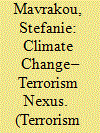

|
|
|
|
|
| Summary/Abstract |
A growing number of policymakers around the world have recognized climate change as an escalating security threat and increasingly point to the climate change—terrorism nexus in particular. This critical literature review provides an analysis of the current state of research on the causal and correlative links between climate change, intermediary factors—such as resource scarcity, loss of economic opportunities, and instability—and terrorism in sub-Saharan Africa. Moving beyond a review of substantive themes within the existing body of scholarly research examining this topic, this article critically evaluates the theories, assumptions, and methods behind the literature. In doing so, the review identifies noteworthy trends, as well as gaps and shortcomings in the current research. Our review finds that the majority of the literature has observed a positive correlation between climate change and terrorism. More precisely, the current body of research overwhelmingly assesses that climate change indirectly leads to terrorism via its impact on conditions often considered to be drivers of terrorism in sub-Saharan Africa. Still, gaps remain in empirically backing up these assertions and examining the relationship between climate change, intermediary factors, and terrorism in more depth. We use our critical review and analysis to guide recommendations for further research into this emerging and timely field of study.
|
|
|
|
|
|
|
|
|
|
|
|
|
|
|
|
| 8 |
ID:
188059
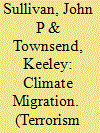

|
|
|
|
|
| Summary/Abstract |
While conflict, crime, and terrorism are persistent geopolitical and human security threats, climate change can be a threat multiplier, affecting geopolitical stability on local, regional, and global scales. This paper provides a qualitative assessment of the literature and geopolitical trends related to climate change, migration, and ethnocentrism in order to evaluate the current situation and future potentials for climate-driven conflict, crime, terrorism, and ethnocentric extremism. The paper concludes that as climate change becomes a major driver of environmental degradation, natural disasters, mass migrations, and urbanization, this will escalate the impetus for violence against migrants, the exploitation of migrants, and anti-migrant politics. Potential implications in terms of terrorism and extremism are discussed.
|
|
|
|
|
|
|
|
|
|
|
|
|
|
|
|
| 9 |
ID:
188098
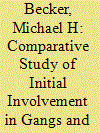

|
|
|
|
|
| Summary/Abstract |
There is a paucity of research comparing gang members and domestic extremists and extant studies find few explicit linkages. Despite this, there remains a great deal of interest in possible similarities between these criminal groups. Driving this interest is the possibility of adapting policies and practices aimed at preventing entry into criminal groups. A critical first step to determining compatibility is to examine the circumstances of the individuals who enter these organizations and better describe the entry processes. This study provides a unique comparison of entry into these groups by drawing on four broad empirically derived mechanisms of group entry using forty-five in-person interviews of U.S. gang members and thirty-eight life history narratives of individuals who radicalized in the United States. Our results reveal that each of the four conceptual categories appeared to influence initial involvement; however, no single mechanism described involvement in criminal groups or differentiated involvement across the gangs and extremist groups.
|
|
|
|
|
|
|
|
|
|
|
|
|
|
|
|
| 10 |
ID:
188089
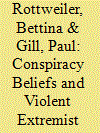

|
|
|
|
|
| Summary/Abstract |
This study analyzes the effects of conspiracy beliefs on violent extremist intentions. More specifically, we investigate whether the relationship between conspiracy beliefs and violent extremism depends upon individual characteristics such as varying levels of self-efficacy, self-control, and law-relevant morality. Variable interactions examine where conspiracy beliefs exert strong effects on violent extremist intentions. The analysis is based on a German nationally representative survey (N = 1502). To our knowledge, it is the first and only nationally representative survey carried out in violent extremism research.
|
|
|
|
|
|
|
|
|
|
|
|
|
|
|
|
| 11 |
ID:
188062


|
|
|
|
|
| Summary/Abstract |
Building on a global research sweep of terrorist organizations’ (as well as other non-state actors such as separatist and insurgent groups) use of fresh water as a target, weapon, or source of control, this paper analyzes attacks on major water projects (specifically dams and other related infrastructure) in South Asia—the region identified to have had the largest number of recorded water-related violent incidents. Focusing on India, Pakistan, and Afghanistan, and the post 9/11 period through 2019, the paper explores how large water infrastructures (and their environs) have become hot spots for violence between states that use water development projects to consolidate power, garner local loyalty, and create a national narrative and non-state actors who attempt to target these same projects to assert indigenous self-determination, subvert state power, or challenge state authority through terrorist means. Since fresh water is shared across borders, dam projects can become entangled in regional political disputes further exacerbating violent conflict between state and non-state actors. Given its impacts on water resources, climate change may act as a “threat multiplier” by enhancing local grievances, providing both government and terrorist groups additional incentives for exploitation, and further contributing to instability. The analysis provided here borrows from and contributes to the fields of development, environment and security, and terrorism studies.
|
|
|
|
|
|
|
|
|
|
|
|
|
|
|
|
| 12 |
ID:
188100
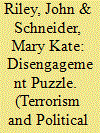

|
|
|
|
|
| Summary/Abstract |
Why do rebels leave rebellions? Although much scholarly attention has been devoted to understanding why individuals join rebellions, relatively little is known about why they leave. This paper seeks to fill this deficit by exploring the decision-making process that rebels undertake when determining whether to stay or leave. Based on interview data collected from ten active rebels and four former rebels all engaged (or previously engaged) in conflicts in East Africa, we find that the reason why rebels joined the group influences their decision to leave or stay. Rebels who joined due to grievances are far less likely to escape opportunistically, while rebels who joined due to “greed” display a higher sensitivity to the hardships of rebel life and the pull of alternative options. Understanding why a person joins a rebellion helps predict the factors that will drive them to leave.
|
|
|
|
|
|
|
|
|
|
|
|
|
|
|
|
| 13 |
ID:
188064
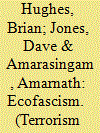

|
|
|
|
|
| Summary/Abstract |
With Patrick Crusuis’ 2019 attack that killed twenty-two people in El Paso, Texas, discussions of ecofascism were thrust into mainstream news outlets and magazines. In his manifesto, Crusius described himself as an “ecofascist” seeking to challenge the “environmental warfare” of immigration. His choice of target, a Walmart frequented by Mexican immigrants, reflects this ideological connection between ecological priorities and violent white supremacist ideology. In this paper, the authors provide a review of existing theoretical literature on ecofascism to identify its key characteristics, namely, its Romantic sensibilities, anti-humanism, and mysticism. The authors argue that these features distinguish ecofascism from what other scholars have deemed “far-right ecologisms.” Following this, the authors draw on a larger corpus of data gathered from Twitter and Telegram between November 2019 and November 2020 to identify common themes in ecofascist circles, including the thinkers they frequently cite. The dataset examined shows notable differences in the types of content shared in ecofascist groups compared to the far-right more broadly.
|
|
|
|
|
|
|
|
|
|
|
|
|
|
|
|
| 14 |
ID:
188106
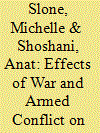

|
|
|
|
|
| Summary/Abstract |
Although research on the consequences of war exposure on children’s mental health has made significant progress in the past decades, a lack of valid measures for quantifying the incidence, severity and variability of exposure can hamper identification of at-risk children and mental health delivery in conflict-affected areas. The present study investigated the psychometric properties of a new political life events scale for youth (PLE-Y) that comprehensively assesses personal political violence exposure history. The PLE-Y was administered to 6,254 adolescents aged twelve to eighteen in two large samples in a region in Israel that has been characterized by high exposure to political violence. Adolescents were assessed for political life events exposure, psychiatric symptoms, emotional and behavioral problems, and subjective well-being. Exploratory and confirmatory factor analyses supported a two-factor structure of the PLE-Y (severe and mild), representing the severity levels of exposure. Results confirmed positive relations between severity of PLE exposure and psychiatric symptoms, emotional and behavioral difficulties, and lower subjective well-being. This study demonstrated the importance of taking into account the personal political violence exposure history and the subjective interpretations of impact of the events to accurately identify the mental health risks to youth who are chronically exposed to protracted political violence.
|
|
|
|
|
|
|
|
|
|
|
|
|
|
|
|
| 15 |
ID:
188102


|
|
|
|
|
| Summary/Abstract |
Many researchers, practitioners, and policymakers are concerned about online communities that are known to facilitate violent right-wing extremism, but little is empirically known about these digital spaces in general and the developmental posting behaviors that make up these spaces in particular. In this study, group-based trajectory modeling—derived from a criminal career paradigm—was used to identify posting trajectories found in the open-access sections of the Iron March and Fascist Forge forums, both of which have gained notoriety for their members’ online advocacy of violence and acts of violence carried out by them. Multinomial logistic regression and analysis of variance were then used to assess whether posters’ time of entry into the violent forums predicted trajectory group assignment. Overall, the results highlight a number of similarities and differences in posting behaviors within and across platforms, many of which may inform future risk factor frameworks used by law enforcement and intelligence agencies to identify credible threats online. We conclude with a discussion of the implications of this analysis, followed by a discussion of study limitations and avenues for future research.
|
|
|
|
|
|
|
|
|
|
|
|
|
|
|
|
| 16 |
ID:
188097
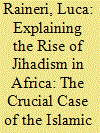

|
|
|
|
|
| Summary/Abstract |
While jihadism appears to be on the rise in Africa, the explanations of violent extremist groups’ capacity to foment jihadi insurgencies and mobilize recruits remain poorly understood. Recent studies have challenged the assumption that the rise of jihadism in Africa is the result of poor governance in areas of limited state reach, highlighting instead the significance of the (perception of) abuses perpetrated by state authorities. Looking at collective action and its structural determinants, it is rather state action—and not the lack thereof—that best explains the capacity of mobilization of jihadi insurgencies in African borderlands. In order to test this theory in a least-likely case, the article explores the genealogy and evolution of the Islamic State in the Greater Sahara (ISGS), mobilizing extensive qualitative evidence. Borrowing the analytical framework from civil war studies, it argues that the contentious political dynamics observed in Niger’s borderlands amount to a case of symmetric non-conventional warfare, where abuses perpetrated by state proxies trigger an escalation of homegrown terrorism. It therefore supplies a further specification of the theories investigating the complex interplay between the processes of jihadi mobilization/rebel governance and the practices of counter-terrorism in weak states.
|
|
|
|
|
|
|
|
|
|
|
|
|
|
|
|
| 17 |
ID:
188079
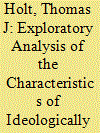

|
|
|
|
|
| Summary/Abstract |
Web defacement is a form of hacking that involves altering the content of a website, resulting in repairs to the website code, loss of revenue, internal loss of productivity, and reputational damage. Limited research has examined the frequency of web defacements, the factors that distinguish them from other hacking motives, and the extent to which the correlates mirror research on physical acts of ideologically-motivated crime. The current study examined over 2.4 million web defacements hosted in the U.S. from 2012 to 2016 to assess aspects of routine activities theory associated with target selection and attack methods among ideologically-motivated defacements. A binary logistic regression analysis revealed that ideologically-motivated defacers were more likely to use unknown vulnerabilities; engage in repeated attacks; target top-level domains linked to foreign nations; domains ending in.edu; and homepages within websites. The findings of this study suggest that the target selection process of ideologically-motivated defacers are more purposive and designed to draw attention to their cause, resembling target preferences of individuals who engage in physical violence in support of an ideological agenda.
|
|
|
|
|
|
|
|
|
|
|
|
|
|
|
|
| 18 |
ID:
188065


|
|
|
|
|
| Summary/Abstract |
Increasing levels of extreme weather patterns and environmental deterioration pose pertinent threats to the availability of essential resources, such as food and water. Past research has found a positive association between climate change and the likelihood of internal conflicts, especially in developing countries. We argue that intensifying climate events can lead to an increase in the spread and intensity of both left and right-wing ideologically motivated violence in developed countries as well, specifically the United States. We also focus on how regional environmental characteristics might be correlated to the geographical distribution of domestic political violence. Our findings suggest that while both far-right and environmental violence are more prevalent during warmer seasons and extreme warming weather events, such as heat waves, political and demographic factors also need to be considered. We also found a strong linkage between man-made ecological damage, as opposed to natural disasters, and the prevalence of eco-violence incidents, especially in states that have a progressive-liberal political culture and high levels of ecological exploitation. We conclude with a brief discussion of findings and suggestions for future research.
|
|
|
|
|
|
|
|
|
|
|
|
|
|
|
|
| 19 |
ID:
188063


|
|
|
|
|
| Summary/Abstract |
“Eco-fascism” has recently regained prominence following two of the most lethal extreme right terrorist attacks: the murderous assault on two mosques in Christchurch, New Zealand, which killed fifty-one, and the massacre at a Walmart in El Paso, Texas, which killed twenty-two. Both of these attacks were justified by their perpetrators, at least in part, in environmental terms. Brenton Tarrant, the Christchurch terrorist, went so far as to proclaim himself an “eco-fascist.” Whilst “radical right” populism is often associated with climate denial, “extreme right” environmentalism, with its roots in the “blood and soil” thinking of Nazism, is concerned with protecting the spiritual link that supposedly exists between man and nature. Having established the historical lineage of such ideas, the article explores how contemporary extreme right groups have reacted to population growth, migration, and climate change. It explores the emergence of a particular form of “dark green” environmentalism that builds upon the “blood and soil” ideas of Nazism, synthesizing them with an anti-human ecology derived from several sources including Greco-French Hitler-worshipper Savitri Devi; the “Unabomber” Ted Kaczynski; and the Finnish environmentalist and misanthrope Pentti Linkola. The misanthropic ideas of these three ideologues and their extreme “solutions” to environmental degradation and overpopulation represent an increasingly prevalent ideological tendency within extreme right subcultures online. The violent panaceas they advocate and envisage as being necessary to defend the natural environment will undoubtedly gain greater prominence as climate change-driven migration northwards to Europe intensifies.
|
|
|
|
|
|
|
|
|
|
|
|
|
|
|
|
| 20 |
ID:
188086


|
|
|
|
|
| Summary/Abstract |
Following the rise in far-right inspired terrorist attacks globally, social media and electronic communications companies have been criticized, mainly by politicians, for allowing far-right extremist content to be available. This article is a comparative legal study focusing on Australia, Canada, New Zealand, the U.K., and the U.S.’ legal provisions regarding the right to freedom of expression, hate crime, and proscription of terrorist organizations. This study found a disparity in the form of expression protected under this right. This disparity widens further when related to hate crime and proscribing groups as terrorist organizations. As such, social media and communications companies have difficulty setting at global level a baseline in determining whether content is legitimate commentary or is extremism promoting or inciting hatred and violence. The article concludes with a recommendation for how states can provide comparable legislation on hate crime as they have done in relation to Islamist inspired extremism. This will assist social media and communications companies in removing content and suspending accounts. These companies are not the guardians of freedom of expression, that is the role of states’ legislatures and judiciary.
|
|
|
|
|
|
|
|
|
|
|
|
|
|
|
|
|
|
|
|
|